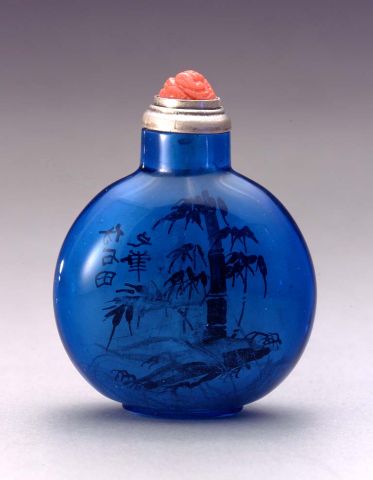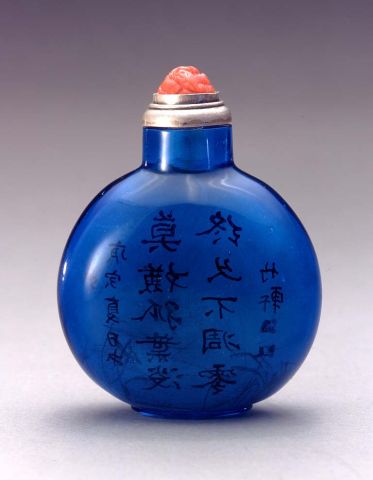

Bottle ID: 00656
ZHU XUAN, BLUE W/BAMBOO & ROCK LANDSCAPE
Date: Summer, 1830
Height: 51 mm
Glass, and ink, of transparent peacock-blue color, of flattened rounded form and a neatly carved oval footrim, painted on the inside in black ink, on one side with bamboo growing from a rocky ground, inscribed in regular script Fang Shitian zhibi (after the brush-style of Shitian), and on the other side with an inscription in regular script, a poem preceded by 'Made on a summer day in the gengyin year' and followed by a signature 竹轩 with two token seals of the artist.
Early Decorative School, attributed to Beijing.
Similar Examples:
Moss, Hugh, Victor Graham and Ka Bo Tsang. A Treasury of Chinese Snuff Bottles - The Mary and George Bloch Collection , 2000, Vol. 4, Part 1, p. 11, fig. 2 and fig. 3.
JICSBS, Spring 1993, p. 16, fig. 44.
Stevens, Bob C. The Collectors' Book of Snuff Bottles, 1976, no. 830.
Low, Denis S. K. More Treasures from the Sanctum of Enlightened Respect, 2002, p. 330, no. 296.
Provenance:
Hugh Moss [HK]
Guwan cheng, Beijing, October, 2005
Exhibited:
Annual Convention ICSBS Toronto, October 2007
The Early Decorative School of inside painted bottles relates to a small group of glass bottles, dated between 1821-1833, one example with a Daoguang reign name (in Y. F. Yang's Collection). One of the art names which appears is Banshan, which interestingly appears on bottles by Yiru Jushi. Hugh Moss discusses the 'Early Decorative School' of inside painted artists, presumed to be from Beijing, in A Treasury of Chinese Snuff Bottles, Volume 4, where a similar bottle in shape and style, but signed with another of this artist's assumed names, is illustrated. Intriguingly it has orchids on a rocky bank and the inscription 'King of Fragrance', whereas this one has bamboo on a rocky bank and a different inscription. Moss states that this school was inspired by the artist Yiru Jushi. In Moss' records there is a bottle by Yiru Jushi which has both subjects, orchids and bamboo, with the same 'King of Fragrance' inscription above the orchids. Moss suggests that the present artist may have seen it and divided the subject into two bottles. Shitian, the artist cited as the inspiration for the brush-style here, is the hao of the famous Ming scholar-painter Shen Zhou (1427-1509). This name was also cited by Yiru Jushi several times in his work as a source of inspiration.
A bottle in the collection of Denis Low (see above) appears to fit into this small group, but raises more questions than answers. It is painted in a similar naïve style with a fisherman and a woodcutter beside rockwork, the reverse with an inscription extolling the virtues of snuff, followed by a hitherto unrecorded two-character name, Ke Tang (Gedong). The date of this bottle is given as 1866, raising the question of why it seems to be the only example surviving which is dated thirty years after the rest of the group. If a school of artists was going to last this length of time, there would be many other bottles remaining in collections today. If the cyclical date of this bottle is taken back to 1806 it would only fit alongside the date range of bottles by Yiru Jushi if one accepts Moss' theory that Yiru Jushi was the first inside painted artist working at the beginning of the nineteenth century. The Low bottle appears to be almost a straightforward copy of a bottle by Yiru Jushi in the Bloch collection (although less detailed), which is dated with the cyclical date 1805.
It is unusual to find these Early Decorative School bottles in colored glass, however, it is perhaps significant that the comparable example cited above, which is in the Earth Museum in London and has been since the late nineteenth century, is of the same form although executed in clear glass.
< Back to full list

 English
English 中文
中文